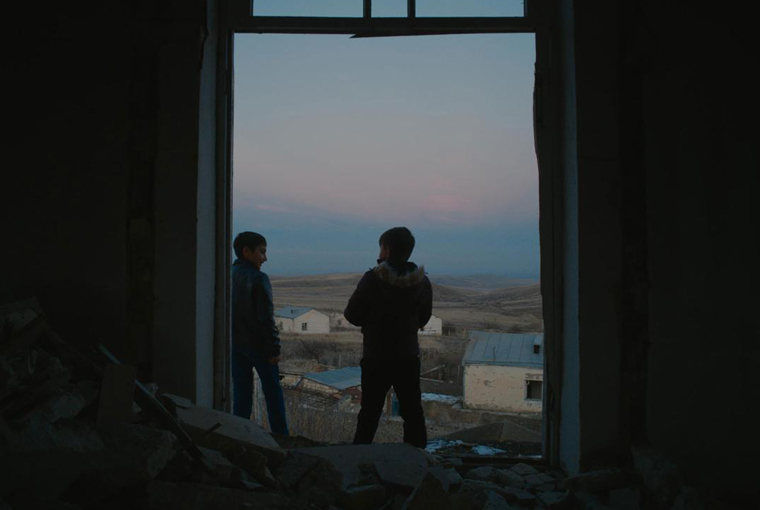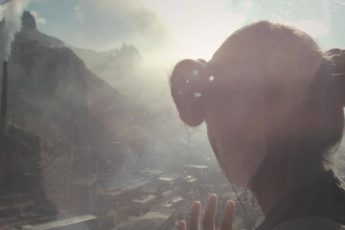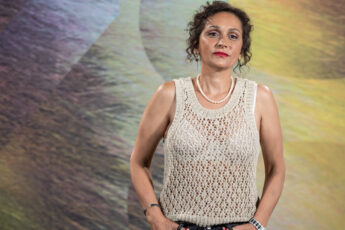Male Vulnerability
Alexis Pazoumian’s Nagorno Karabagh: Two Children in the War (2020), Louise Martin Papasian’s Drafted (Appelé, 2021) & Raffi Movsisyan’s Homecoming (2020)
Vol. 122 (February 2022) by Melina Tzamtzi
The 18th edition of the Golden Apricot International Film Festival remained loyal to its central mission of building bridges between different cultural backgrounds. Its self-understanding as a “crossroads of cultures and civilizations” is a logical consequence of Armenia’s recent political condition: the wounds of the war between Armenia and Azerbaijan that nominally ended in November 2020 are still very fresh. This has necessitated the creation of a space to explore conflicts on both a macro- and a micro-scale, and to have “differences” coexist peacefully. If we add the pandemic to the equation with its emotional and social side-effects that have arisen across continents and cultural backgrounds, one can’t help but sympathize with the festival’s thematic intent.
The domestic selection of shorts (“Apricot Stone”) offered a panorama of the many cinematic perspectives on recent issues, proving that Armenian cinema is ready to tackle them head-on. Here the material and mental consequences of the war played a central role. In Alexis Pazoumian’s Nagorno Karabagh: Two Children in the War, an ARTE-produced reportage that features narration in French, we follow the events that unfolded in the village of Talish. The village is one of many contested settlements that was alternately controlled by Azerbaijan and Armenians, finally coming under Azerbaijani control with the end of the 2020 military confrontation. As is suggested by the title, the film centers around two children, schoolboys Avo and Samuel. In the opening scene, we see Avo and Samuel revisiting their old school and enjoying themselves in the ruins. The joyful routine among broken glass and rubble turns into a remembrance of shelling. “Were you scared?” Samuel asks. “No, I laughed” Avo responds. At that moment in the film, the war does not seem to have fully consumed the lives of the two boys yet. Being able to stay in their village and being able to stay together seems enough to sustain their youthful carelessness. But their childhood will soon be tarnished. As the village is evacuated, the first signs of bitterness and early severity appear. They have lost their home, their belongings, and are pulled away from each other.
The director reflects on the special conditions that modern technology bestows on this reality. Samuel’s grandmother watches the bombings of her surroundings on her smartphone as if she were watching a daily TV show, and when the two boys meet again, Avon shows Samuel the moment when the Azerbaijani forces break into his own house. In these scenes, the director succeeds in portraying the potential of becoming witness to your own personal horror via your own personal screen. Still, the film is dotted with small moments of analogue joy. Samuel and Avon still engage in silly childhood games, now at the sea rather than in the mountains. Being reunited seems meaningful even as they reflect on their feelings for Talish and share how they miss their home.
Besides the importance of communality, the shared faith of Avon and Samuel in the face of war and expulsion broaches another theme that springs up time and again in other domestic shorts as well: the challenge of becoming a grown-up, and specifically a man. In Louise Martin Papasian’s Drafted, a young man recounts how his conscription disturbed his sleep. Since he had to join the army, his dreams have vanished. The set-up of having a young man analyze his dreams in a military and hence conventionally “masculine” environment is immediately engaging. The young man’s contemplation is complemented by the image of him standing in his uniform and playing with a silver prayer bead. This adds up to an introspective illustration of male vulnerability in the context of conflict and war.
A similar theme is addressed in Homecoming by Raffi Movsisyan. In this ironically titled film, Movisyan illustrates how a seemingly joyful event – the homecoming of a family father for New Year’s celebrations – can quickly turn sour. In the beginning, the homecoming brings excitement. Everyone is looking forward to greeting the man, who appears to be respected in his native village. The children show off the cool toys they got from him, while the women of the family try and dish up something special. The man is also happy to go back and finally be rejoined with his family. But the melancholic looks of his sons, who seem awkward in their father’s presence, betray that the positive atmosphere is actually a bit forced. And sure enough, the man’s personality is revealed at dinner. A musical performance by two of his sons underscores one of his children’s sensitive and introverted nature, which stands in stark contrast to his own bearing, which adheres to the old ideals of patriarchy (not coincidentally, the father is an admirer of Putin). He blames his wife for their upbringing and will later “punish” her by physically abusing her. While one of the sons stands up to his father for his brash and authoritarian bearing, the younger one is confused by his father’s behavior and acts scared and distant. The film thus brings out how cultural shifts manifest in nuclear family relationships, and illustrates that the male models they engender can often not coexist peacefully, especially when met with closemindedness and intolerance.




Leave a Comment